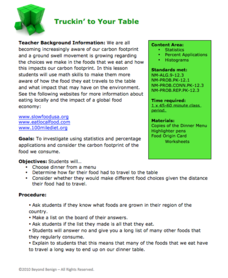Statistics Education Web
Text Messaging is Time Consuming! What Gives?
The more you text, the less you study. Have classes test this hypothesis or another question related to text messages. Using real data, learners use technology to create a scatter plot and calculate a regression line. They create a dot...
Illustrative Mathematics
Fixing the Furnace
This comprehensive resource applies simultaneous equations to a real-life problem. Though the commentary starts with a graph, some home consumers may choose to begin with a table. A graph does aid learners to visualize the shift of one...
Federal Reserve Bank
Expense Tracking
Where does all your money go? Individuals keep a record of the money they spend over the course of 30 days. They then categorize where they are spending their money and write an essay detailing their findings.
Federal Reserve Bank
Financial Goals
Do you have financial goals? How will you make them happen? Help your pupils answer these questions through this interactive project. They create goals and a plan for reaching them as one of many high school algebra projects.
Curated OER
Citrus Fruit Counting and Problem Solving
In these two counting citrus fruits worksheets, students add and subtract by coloring the fruits and solving the problems and problem solving consumer math word problems. Students solve 12 problems.
Math Worksheets Land
Multistep Ratio and Percent Word Problems - Independent Practice Worksheet
Math in real life IS a thing and your learners can see how when they practice ratio word problems. Use the handy ratio to convert between measurements and figure out the answer when given a change of information. Resource also comes with...
Consumers Energy
The Cost of Electricity
How much is your toaster costing you every day? Young environmentalists calculate the monetary costs of household appliances based on their average consumption of wattage.
EngageNY
Markup and Markdown Problems
There is a 100 percent chance this resource will help pupils connect percents to financial literacy. Young mathematicians use their knowledge of percents to find markups and markdowns in financial situations in the seventh segment in a...
Curated OER
Problem-Solving Application: Choosing Reasonable Answers
In this reasonable answers worksheet, 1st graders apply their knowledge of how to select the most reasonable answer regarding the appropriate tool to use for measurement of different objects. There are 4 problems to solve.
Curated OER
Shapes for Sale!
In this visual thinking worksheet, students use the price tags on the 3 basic shapes at the top of the page to determine the costs of each of the 6 more complex shapes on the page. They then make their own complex shape and ask a...
EngageNY
Conducting a Simulation to Estimate the Probability of an Event II
Add some randomization into simulations. The 11th installment in a series of 25 presents two new methods to use in simulations--colored disks, and random numbers. Pupils use random numbers to run simulations where the probabilities make...
Curated OER
Money Amounts
In this consumer math activity, students write the amount of money they see in decimal form. They identify and total both paper money and coins in 4 examples. They identify bills up to $100 and coins from a penny to a dollar.
Curated OER
Write the Money in Decimal Form
In this consumer math worksheet, students total the monetary amounts using both paper money and coins in 4 examples. They work with paper money up to $50 bill and coins up to quarters.
Curated OER
Fuel Cell Experimentation
With rising oil prices and increasing concerns over global warming, the pressure is on for engineers to develop alternative sources of energy. Among the new technologies being developed are hydrogen fuel cells, which young scientists...
Beyond Benign
Truckin’ to Your Table
Food takes a trip to the table. Class members choose a meal from a menu and calculate the total cost of the meal including tax and tip. Using a food origin card, pupils determine how far each of the ingredients of a meal traveled to end...
EngageNY
Summarizing Deviations from the Mean
Through a series of problems, learners determine the variability of a data set by looking at the deviations from the mean. Estimating means of larger data sets presented in histograms and providing a way to calculate an estimate round...
Beyond Benign
Ecological Footprint
How does your lifestyle measure up in terms of your ecological footprint? Young ecologists examine their impact on the planet using an insightful online calculator. A short quiz asks users to rank the size of their homes, their energy...
Curated OER
Acceptance Sampling
For this algebra lesson, learners sample food and identify acceptance sampling. They create specific plans to meet specific situations as they sample the food. There are 6 questions.
Curated OER
Less vs. Fewer
When should you use less, and when should you use fewer? Straighten out this dilemma with a helpful resource about using less vs. fewer based on sentence context clues. After reading detailed instructions and examples, young learners...




















